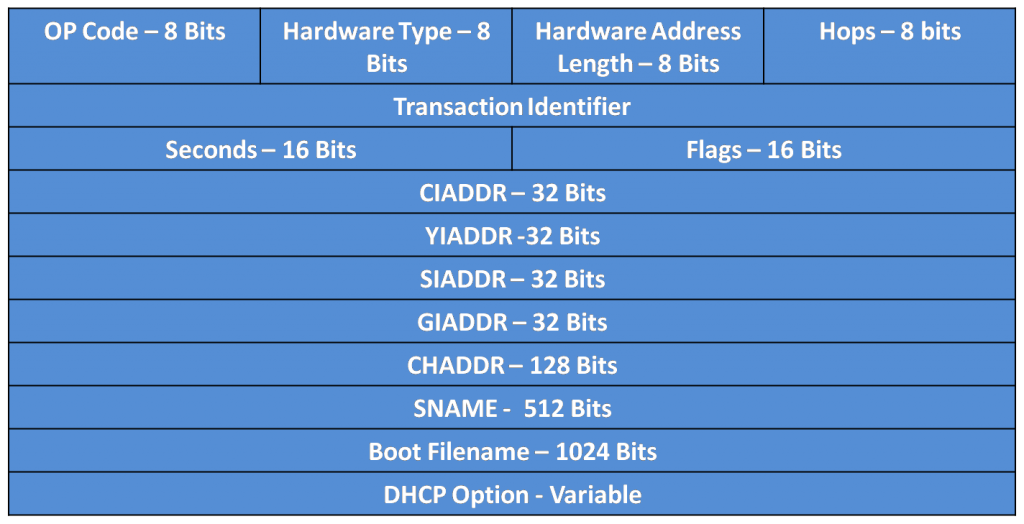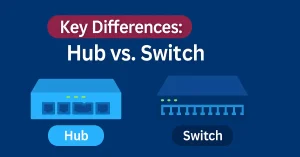Dynamic Host Configuration Protocol version 4 (DHCPv4) is a cornerstone of IP address management in IPv4 networks, automating the assignment of IP addresses, subnet masks, default gateways, and other network parameters. Based on the Bootstrap Protocol (BOOTP), DHCPv4 uses UDP ports 67 (server) and 68 (client) to exchange messages between clients and servers. This article explores the DHCPv4 message format, its fields, practical applications, and troubleshooting tips, providing a comprehensive guide for Cisco certification preparation.
DHCPv4 Message Format
DHCPv4 messages follow a standardized format derived from BOOTP, ensuring compatibility and efficient communication. The format includes fixed-length fields and a variable-length options field, allowing clients and servers to exchange critical IP configuration data. The figure below illustrates this structure, which is essential for understanding DHCP operations in Cisco networks.
DHCPv4 Field Descriptions
Each field in the DHCPv4 message serves a specific purpose, enabling seamless IP address allocation. Below is a detailed breakdown of each field, with practical context for CCNA and CCNP students.
OP Code
The Operation Code (OP Code) is an 8-bit field specifying the message type. A value of 1 indicates a REQUEST message (e.g., DHCPDISCOVER, DHCPREQUEST), while a value of 2 indicates a REPLY message (e.g., DHCPOFFER, DHCPACK). For example, a client sends a DHCPDISCOVER (OP Code = 1) to locate a DHCP server, and the server responds with a DHCPOFFER (OP Code = 2).
Hardware Type
This 8-bit field identifies the type of hardware used in the network, typically Ethernet (value = 1). It specifies the format of the hardware address in the CHADDR field, ensuring compatibility between client and server communications.
Hardware Address Length
This 8-bit field indicates the length of the client’s hardware address in bytes. For Ethernet, this is typically 6 bytes, corresponding to the MAC address length.
Hops
The Hops field (8 bits) tracks the number of relay agents a DHCP message passes through. Clients set this field to 0, and each relay agent increments it, helping control message forwarding in complex networks.
Transaction Identifier
The Transaction Identifier (32 bits) is a unique value generated by the client to match requests with server replies. For instance, a client includes the same Transaction ID in a DHCPDISCOVER and DHCPREQUEST to ensure the server’s DHCPOFFER and DHCPACK correspond to the correct request.
Seconds
This 16-bit field indicates the elapsed time in seconds since the client began attempting to obtain or renew an IP address lease. Servers use this to prioritize responses when multiple clients are requesting addresses simultaneously.
Flags
The Flags field (16 bits) includes the broadcast flag (leftmost bit). When set to 1, the server sends replies via broadcast, ensuring clients without an IP address (e.g., during initial discovery) can receive responses. This is critical in multi-subnet networks where relay agents are used. The remaining 15 bits are reserved for future use.
CIADDR (Client IP Address)
The Client IP Address (CIADDR) field contains the client’s current IPv4 address during lease renewal when the address is valid. If the client lacks a valid IP (e.g., during initial discovery), this field is set to 0.0.0.0. For example, a client in the BOUND state includes its IP in CIADDR when sending a DHCPREQUEST for renewal.
YIADDR (Your IP Address)
The Your IP Address (YIADDR) field holds the IPv4 address assigned by the server to the client. In a DHCPOFFER, the server populates YIADDR with a proposed IP, which the client accepts in a DHCPREQUEST.
SIADDR (Server IP Address)
The Server IP Address (SIADDR) specifies the IP of the next server in the bootstrap process, often the DHCP server itself. In environments with multiple DHCP servers, SIADDR helps clients identify the correct server for subsequent requests, ensuring accurate communication.
GIADDR (Gateway IP Address)
The Gateway IP Address (GIADDR) field is set by the relay agent to indicate its interface IP, enabling DHCP servers to assign IPs to clients on different subnets. For example, in a VLAN setup, GIADDR ensures the server assigns an IP from the correct subnet’s pool.
CHADDR (Client Hardware Address)
The Client Hardware Address (CHADDR) contains the client’s MAC address, used to match requests and responses. For instance, a server uses CHADDR to ensure a DHCPOFFER reaches the correct client in a network with multiple devices.
Optional DHCP Fields
The Server Name (SNAME) and Boot Filename fields are optional and used in DHCPOFFER and DHCPACK messages. SNAME may contain the server’s nickname or DNS name (e.g., dhcpserver.netacad.net), while Boot Filename specifies the boot file’s directory and name, aiding clients in the bootstrap process. These fields enhance flexibility in complex network environments.
DHCP Options
The DHCP Options field is variable-length and holds parameters like subnet mask, default gateway, and DNS server IPs. Both clients and servers use this field to exchange additional configuration data, making it essential for DHCP’s functionality.
DHCPv4 Message Exchange Example
Understanding how DHCPv4 fields are used in practice is key for CCNA and CCNP students. The table below summarizes field values during a typical DHCP message exchange (DHCPDISCOVER, DHCPOFFER, DHCPREQUEST, DHCPACK):
| Message Type | OP Code | CIADDR | YIADDR | Flags | CHADDR Example |
|---|---|---|---|---|---|
| DHCPDISCOVER | 1 | 0.0.0.0 | 0.0.0.0 | Broadcast (1) | 00:1A:2B:3C:4D:5E |
| DHCPOFFER | 2 | 0.0.0.0 | 192.168.1.10 | 0 | 00:1A:2B:3C:4D:5E |
| DHCPREQUEST | 1 | 0.0.0.0 | 192.168.1.10 | 0 | 00:1A:2B:3C:4D:5E |
| DHCPACK | 2 | 192.168.1.10 | 192.168.1.10 | 0 | 00:1A:2B:3C:4D:5E |
This exchange can be analyzed using Wireshark with the filter udp.port == 67 or udp.port == 68. The diagram below illustrates this process.
DHCPv4 vs. DHCPv6
For CCNP students, understanding the differences between DHCPv4 and DHCPv6 is essential, especially with IPv6’s growing adoption. The table below compares key aspects:
| Feature | DHCPv4 | DHCPv6 |
|---|---|---|
| Ports | UDP 67/68 | UDP 546/547 |
| Address Type | IPv4 | IPv6 |
| Message Format | BOOTP-based | Unique format |
| Use Case | IPv4 networks | IPv6 networks, SLAAC |
DHCPv6 uses a different message format and ports (546/547) to support IPv6’s larger address space. Unlike DHCPv4, DHCPv6 often works with Stateless Address Autoconfiguration (SLAAC), allowing clients to self-configure addresses while obtaining other parameters (e.g., DNS) from a DHCPv6 server.
Conclusion
Mastering the DHCPv4 message format and its applications is vital for success in network management. By understanding fields like OP Code, CIADDR, and GIADDR, and applying troubleshooting and configuration skills, you’ll be well-prepared for Cisco exams and real-world networking.
FAQs
What is the purpose of the OP Code in DHCPv4 message format?
The OP Code is an 8-bit field in DHCPv4 that specifies the message type, with 1 for REQUEST (e.g., DHCPDISCOVER) and 2 for REPLY (e.g., DHCPOFFER), enabling client-server communication for IP allocation.
How does the CIADDR field function in DHCPv4?
The CIADDR field holds the client’s current IPv4 address during lease renewal. If invalid (e.g., during discovery), it’s set to 0.0.0.0, aiding servers in managing IP assignments effectively.
What role does the GIADDR field play in DHCPv4?
The GIADDR field, set by relay agents, indicates their interface IP, allowing DHCP servers to assign IPs to clients on different subnets, crucial for VLAN setups and multi-subnet networks.
How can I troubleshoot DHCPv4 issues like incorrect CIADDR?
If CIADDR is incorrect, verify the client’s state and clear bindings using clear ip dhcp binding on Cisco devices, ensuring proper lease renewal and server response.
What are the key differences between DHCPv4 and DHCPv6?
DHCPv4 uses UDP 67/68 for IPv4, based on BOOTP, while DHCPv6 uses 546/547 for IPv6 with a unique format, often paired with SLAAC for address configuration.





